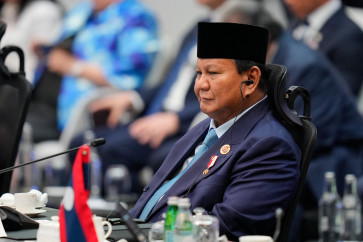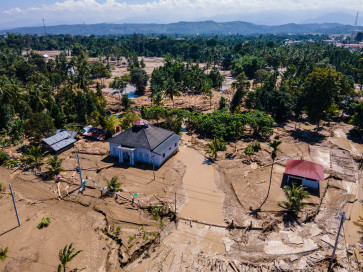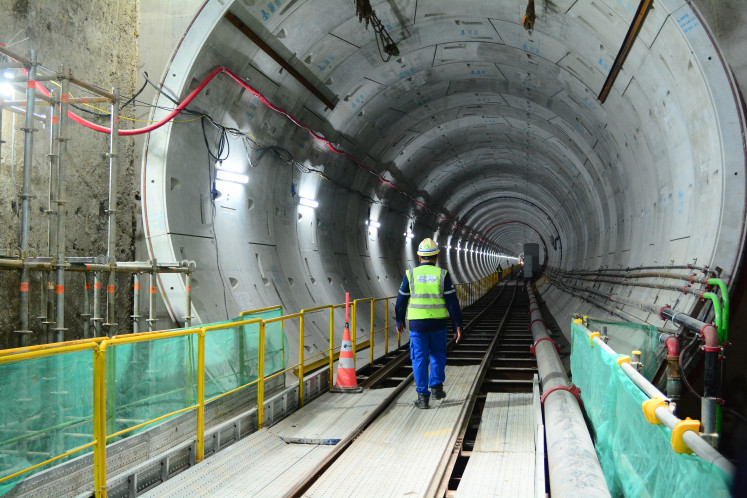Popular Reads
Top Results
Can't find what you're looking for?
View all search resultsPopular Reads
Top Results
Can't find what you're looking for?
View all search resultsNatural caves lack ecotourism guidelines
A tourist crosses a valley on a flying fox near Goa Ngingrong (Ngingrong Cave) in Mulo village, Gunungkidul regency
Change text size
Gift Premium Articles
to Anyone
 A tourist crosses a valley on a flying fox near Goa Ngingrong (Ngingrong Cave) in Mulo village, Gunungkidul regency. Home to hundreds of natural caves, Indonesia is a great destination for ecotourism lovers. However, although such locations are already operating as tourist sites, the government lacks cave utilization guidelines. (thejakartapost.com/Bambang Muryanto) (Ngingrong Cave) in Mulo village, Gunungkidul regency. Home to hundreds of natural caves, Indonesia is a great destination for ecotourism lovers. However, although such locations are already operating as tourist sites, the government lacks cave utilization guidelines. (thejakartapost.com/Bambang Muryanto)
A tourist crosses a valley on a flying fox near Goa Ngingrong (Ngingrong Cave) in Mulo village, Gunungkidul regency. Home to hundreds of natural caves, Indonesia is a great destination for ecotourism lovers. However, although such locations are already operating as tourist sites, the government lacks cave utilization guidelines. (thejakartapost.com/Bambang Muryanto) (Ngingrong Cave) in Mulo village, Gunungkidul regency. Home to hundreds of natural caves, Indonesia is a great destination for ecotourism lovers. However, although such locations are already operating as tourist sites, the government lacks cave utilization guidelines. (thejakartapost.com/Bambang Muryanto)
A
span class="caption">A tourist crosses a valley on a flying fox near Goa Ngingrong (Ngingrong Cave) in Mulo village, Gunungkidul regency. Home to hundreds of natural caves, Indonesia is a great destination for ecotourism lovers. However, although such locations are already operating as tourist sites, the government lacks cave utilization guidelines. (thejakartapost.com/Bambang Muryanto)
Home to hundreds of natural caves, Indonesia is a great destination for ecotourism lovers.
Particularly in Yogyakarta province, many caves are situated in karst areas including on Mount Sewu in Gunungkidul regency, which has been recognized as a world geopark by UNESCO.
Unfortunately, according to Indonesia Speleological Society chairman Cahyo Rahmadi, the government does not yet have cave utilization guidelines despite such locations operating as tourist sites.
Goa Gong (Gong Cave) in East Java, he said, was vandalized due to a lack of barriers between visitors and parts of the cave.
Situated in Bomo village, Punung district, around 37 kilometers from the southern part of Pacitan city in East Java, Gong Cave is said to have the most beautiful stalactites and stalagmites in Southeast Asia. They are also unique because, as the cave's name suggests, they make gong-like sounds when hit.
"Many of the Goa Gong features were ruined and the colors have changed," Cahyo told thejakartapost.com on Monday, adding that karst caves, which had gone through millions of years of formation, were very difficult to repair.
As caves are also a habitat for many species of animals that live in rivers or puddles within them, Cahyo said that area mapping was needed to ensure visitors would not disturb the balance of the aquatic biota.
According to Cahyo, the government was currently drafting a bill on karst ecosystem management and protection, adding that guidelines for cave utilization could be derived from the regulation.
During a recent discussion on karst ecotourism, the tourism manager of Goa Ngingrong (Ngingrong Cave) in Mulo village, Gunungkidul regency, Mursidi, said his team desperately needed knowledge on speleology to enable them to provide scientific explanations to visitors.
"We also want to install lamps inside the cave," said Mursidi.
Cave and ecotourism experts have disputed the plan as not only could it ruin the cave's natural beauty but it may also affect its ecosystem. Based on experience, said one of the experts, moss would grow in areas near the lamps due to the warmer temperatures, which could potentially harm other features of the cave.
Ngingrong Cave is an increasingly popular spot for tourists because of the ease of access on the side of a road. The cave mouth is situated at the bottom of a valley around 70 meters deep and visitors can also explore three ponds inside. Those who feel reluctant to enter can opt to cross the valley on a flying fox.
According to Kanopi Indonesia ecotourism expert Akbar Aryo Digdo, the number of tourists coming to Gunungkidul had increased from 687,000 in 2010 to 3.6 million last year.
He said that tourist numbers needed to be shared across several sites to avoid crowding in one particular place such as that seen in Goa Pindul (Pindul Cave). (kes)(+)









